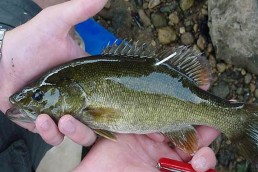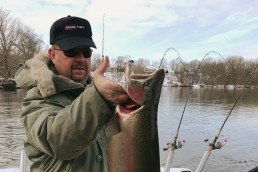Salmon Anglers Flock to the St. Joe River
SHARE THIS POST
Fall is here. There is a chill in the air, and the leaves are turning colors from green to yellow to red. Salmon fishermen in northern Indiana always look forward to the fall months of September and October, and for good reason. This is “prime time” for the annual coho salmon run in the tributaries to Lake Michigan, and the fishing this year should be excellent.
Although Trail Creek and the Little Calumet River often host good fall coho fisheries, the St. Joseph River has been red hot in recent years. Chinook salmon fishing in Indiana has suffered in the past several years, but the coho salmon fishing remains very good. It’s always smart to target the fisheries that are thriving!
Lake Michigan Fisheries Biologist Ben Dickinson, from the Indiana Department of Natural Resources (DNR), helps manage the lake’s salmon populations, and he suggests anglers target coho salmon this fall. “Quite honestly, right now the best fall salmon fishery in Indiana is for coho salmon on the St. Joe River,” he reported.
“We made a change in 2015/2016 to hold over our fall fingerling coho salmon for four more months in the hatchery and stock them in the St. Joseph River as large spring yearlings,” Dickinson continued. “We are stocking 60,000 spring yearling coho there. Without increasing the stocking number, we boosted the return of coho through the South Bend Fish Ladder from an average of 1,300 fish to nearly 6,000 coho in September and October during the last two years.”
The DNR’s new strategy of stocking spring yearlings has led to much higher survival for the young salmon since the fish are bigger and it is easier for them to avoid predators. They also spend less time in the river before heading out to the main lake, which also increases their survival and allows them to grow faster.
“As adults, these coho start their spawning run in September and stack up in South Bend and Mishawaka below the dams through the month of October,” said Dickinson. “They seek out gravel beds and are quite aggressive for anglers using artificial lures like inline spinners or small plugs.” Coho salmon are especially aggressive and territorial when they first enter the river, so be ready for fast action when the fish first show up.
Are you enjoying this post?
You can be among the first to get the latest info on where to go, what to use and how to use it!
Some of the most productive inline spinners for these aggressive fish include Mepps Aglia spinners (either plain or dressed), Panther Martin Original or WillowStrike spinners, and Rooster Tail spinners. Many color combinations are productive, but silver/black, silver/orange, orange/black, chartreuse and firetiger are always good.
Small crankbaits can also be hot coho producers on the St. Joe, especially rattling versions. Just be sure to choose models that don’t run too deep, or you will lose too many lures to underwater obstructions. Some excellent choices include Storm Hot-N-Tots, Storm Wiggle Warts, Reef Runner Little Rippers and Rapala Shad Raps.
Of course, coho salmon will also take a variety of natural baits in addition to the artificial lures. Salmon eggs (spawn sacks), live minnows, squid strips and live nightcrawlers are all good choices for bait fishermen. These baits can be drifted with the river’s current under a small bobber or float, or they can be bounced along the bottom with the current. Just be prepared to lose plenty of hooks and other terminal tackle to underwater rocks and snags.
Anglers can catch coho salmon on the St. Joe in many of the same spots where steelhead are found. In Mishawaka, search for gravel bars around the Frank Zappia access site and the Twin Branch Dam. There are good areas to try around Central Park, too. In South Bend, Keller Park and Leeper Park produce good numbers of fish, as well. Where you find one salmon, others will likely be nearby as well.
Although the increased numbers of returning salmon appear to be a result of the new stocking plan, other factors are at play, too. “The state of Michigan also stocks some coho salmon in their portion of the St. Joe,” explained Dickinson. “Since we have achieved a higher return of our fish up to the South Bend area, we’ve noticed more of the Michigan-stocked fish showing up in our waters, too. Perhaps they just like following the crowd upstream!”
Salmon fishermen never complain about more opportunities for catching fish. With the extra salmon that are arriving in the river, there is plenty of action for shore anglers, waders and boat anglers alike. The St. Joe is also home to good numbers of steelhead trout, smallmouth bass, walleyes and channel catfish, so you never know exactly what you will catch. It’s a great fall fishery!
MWO
SHARE THIS POST
Did you enjoy this post?
You can be among the first to get the latest info on where to go, what to use and how to use it!
Tom Berg
A lifelong outdoorsman and award-winning outdoor writer and nature photographer, Tom Berg has been the Executive Director/Treasurer of the Hoosier Outdoor Writers group for the past 14 years. When he is not writing, he would rather be outside fishing, hunting or trapping than doing just about anything else.



